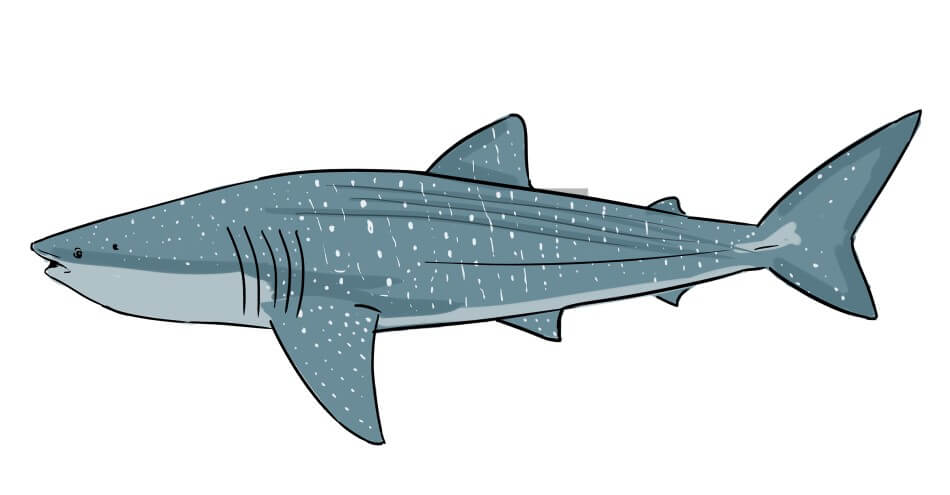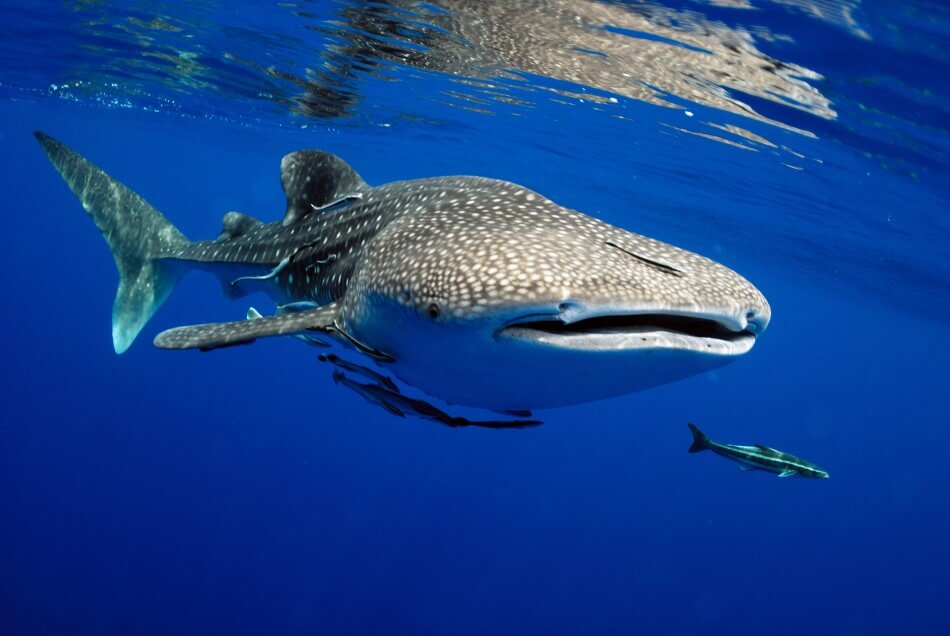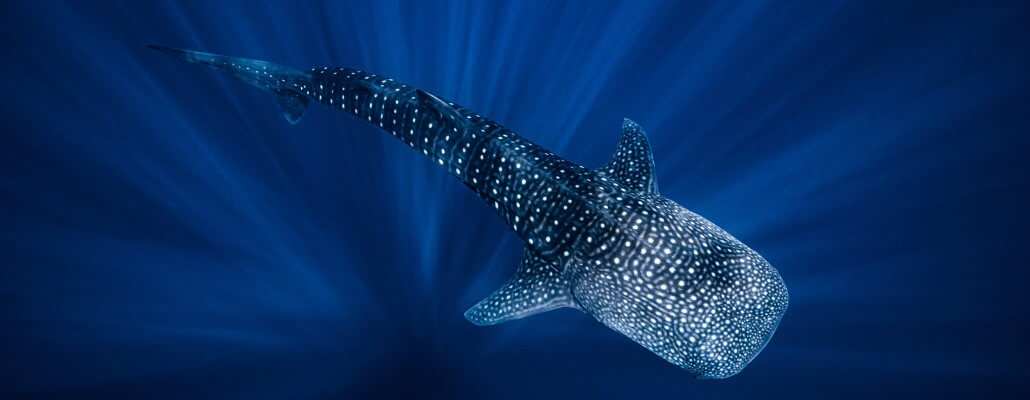The Whale Shark is the largest known species of fish, widely recognised as a true gentle giant. Slow moving and filter feeding, Whale Sharks have shown little apprehension or fear towards humans, and while their huge size is intimidating, they happily swim alongside divers and fellow fish alike.
Able to reach lengths of 41.50 ft, it’s easy to understand how pirates and sailors of old had stories of encountering colossal sea monsters on their travels. Sightings close to the shore are uncommon, as they often stick to the open waters, and are known to undertake long migrations to reach feeding areas that are rich in food sources.
1. The Whale Shark is the largest known fish.
The biggest ever was caught near Baba Island, Pakistan and measured 41.5ft, and weighed 21.5 tonnes.
2. Their markings are unique to each individual
Just like our fingerprints! It makes identification much easier.
3. Their diet consists of plankton such as krill, and occasionally small fish or crustaceans.
Circling the surface with their mouth wide open usually indicates high levels of food in the water.
4. Feeding consists of ‘vacuum’ immense amount of water and filtering out the microscopic plankton.
A special sieve-like apparatus along the gill rakers traps everything but water.
5. Whale Sharks have lots of minute teeth but they serve no purpose during feeding.
As such, they pose no danger to humans.
6. Whale sharks are solitary animals.
Though have been observed congregating in large numbers during feeding.
7. Cruising at low speeds for long periods of time allows them to travel great distances.
They have been known to migrate across the globe for long periods of time.
8. Australia is the most common location for spotting Whale Sharks.
They can be found in warm and tropical seas around areas such as India, Belize, South Africa, Mexico and more.
9. They reach sexual maturity at 30 years.
Whale Sharks are ovoviviparous, meaning their eggs hatch internally before giving birth to pups.
10. Whale Sharks are currently vulnerable.
Threats a predominantly human related, being hunted for the fins, skin, meat and oil.
Whale Shark Fact-File
| Kingdom | Animalia |
| Phylum | Chordata |
| Class | Chondrichthyes |
| Subclass | Elasmobranchii |
| Superorder | Selachimorpha |
| Order | Orectolobiformes |
| Scientific Name | Rhincodon typus |
| Type | Fish |
| Diet | Carnivore |
| Size | 9.7 – 12.65m (31-41ft) |
| Weight | 13,000 – 18,000kg (15-20tons) |
| Top Speed | 16km/h (10mph) |
| Lifespan | 60-70 years (In Wild) |
| Conservation Status | Vulnerable (Threatened) |
Anatomy
The Whale Shark boasts a large streamlined body, with a flat and broad head. The size of it’s mouth is predominantly due to it’s feeding habits, filtering large amounts of plankton (and any small fish that happen to get in the way!) by sucking in immense amounts of water. Once the mouth is closed the water flows out through its gills, resulting in the plankton being trapped against a fine sieve-like apparatus along the gill rakers. Nothing but water is able to pass through this sieve. Like most sharks Whale Sharks do have many teeth, but they are minute and serve no purpose during feeding.
Prominent ridges feature along the length of the Whale Shark’s body, with a large first dorsal fin, followed my a smaller second dorsal fin set further back. The markings of a Whale Shark bare similarities to our finger prints, with every pattern being completely unique to each individual, making it much easier for researchers to identify them.
The average Whale Shark measures around 25 feet (7.6m), weighing around 15-20 tonnes. The largest recorded Whale Shark was caught near Baba Island, Pakistan, measuring 41.5ft and weighing 21.5 tonnes.
Behaviour
As mentioned, the Whale Shark poses no real danger to humans. Despite their huge size, they are a placid and docile fish that are even known to allow divers to hold on for a ride. They are mostly observed as being solitary animals, though large numbers have been spotted congregating around certain areas (Isla Contoy, Mexican Caribbean) potentially for feeding or breeding.
Whale sharks have shown the capacity to learn certain things, particular within captivity. If a keeper appears with food the sharks are known to swim in circles around the feeding point, and are also curious when it comes to fishing boats, with reports of Whale Sharks accepting food from fishermen.
They can typically be found cruising at low speeds, with the capabilities sustain this for long periods of time, allowing them to travel very long distances. During the day they mostly spend their time towards the surface, before diving into the depths during the darker hours.

Diet
Whale Sharks feed on a wide range of microscopic plankton such as krill, and change their feeding techniques depending on the density of prey in the water. For example, if a Whale Shark is ram-feeding in circular motions on the surface with the top of its mouth above the waterline, this usually suggests that there is a dense plankton presence.
They are also known to consume small fish, crustaceans and squid, if they so happen to be caught up amongst plankton while feeding. Whale Sharks are able to process over 1,500 gallons of water each hour due to its vacuum like feeding habits.
Habitat & Distribution
These gentle giants roam the oceans of the globe, sticking to tropical and warm seas. Although solitary, they are known to congregate where high densities of plankton can be found, making it easier researches and tourists alike to find them. While they are capable of diving to depths of up to 1,286m, they are typically found in the open sea as opposed to much deeper parts of the ocean.
Australia is widely known as the most common place to spot Whale Sharks, though they can also be found in wide range of regions such as Maldives, South Africa, India, Mexico and the Galapagos Islands.
Whale Sharks are a migratory species though very little is known about their migration patterns. Research is currently being undertaken to better understand where Whale Sharks migrate to and the reasons for doing so. Unfortunately they are at high risk of being hunted once they leave the protected waters of Australia, with a large number being slaughter for their meat or shark fins.

Reproduction & Offspring
The mating or birth of Whale Sharks is still shrouded in mystery, yet to be observed in the wild. A captured pregnant female revealed that like the Great White and many other species, they are ovoviviparous, meaning they hatch their eggs internally before giving birth. This means their pups are stronger and more likely to survive, each one measuring 40-60cm in length.
Sexual maturity is reached at around 30 years of age, with an estimated lifespan of around 70 to 100 years.
Conservation Status

Unfortunately like many shark species, the Whale Shark is currently endangered. It’s hard to estimate the global population, but they are considered threatened due to their long life spans and thus late sexual maturation.
Humans are most dangerous predator, hunting them for their meat, skin, fins and oil, and also greatly impacting them through devastating oil spills.
